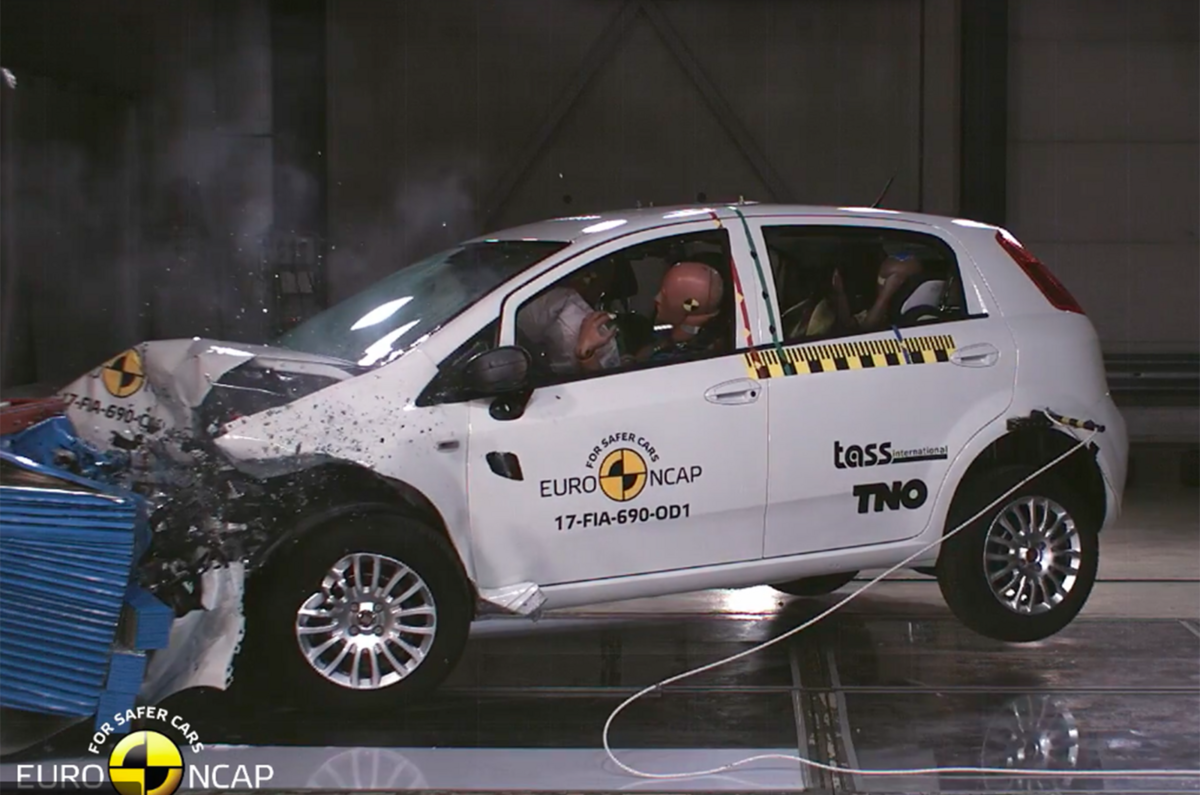The Fiat Punto has received Euro NCAP’s first zero-star score, sparking concern at the crash-testing organisation, as have the three-star ratings of several other cars.
In the latest batch of tests, the Alfa Romeo Giulietta, Dacia Duster, DS 3, Ford C-Max, Ford Grand C-Max, Kia Stonic, MG ZS, Toyota AygoFord andFord Vauxhall Viva all achieved three-star ratings in their standard forms. The Aygo increases to four stars and the Stonic to five stars with optional safety equipment fitted.
After every car tested in the previous two batches scored a five-star rating, the results are a comedown for Euro NCAP.
The Punto gained special attention from the body's secretary general, Michiel van Ratingen, who said: “The fact that older cars cannot compete illustrates the pace at which the vehicle industry is innovating safety and the willingness and ability of competitive manufacturers to meet the highest standards. Those who do not keep their cars up to the latest standards get left behind, as these results clearly show.”
The third-generation Punto was launched in 2005, making the car a twelve-year-old model. It wasn't replaced following the 2008 economic downturn upon Fiat boss Sergio Marchionne’s decision.
Continuing, van Ratingen said: “This is perhaps the strongest example of a manufacturer continuing to sell a product that is well past its best-before date at the expense of the unsuspecting car buyer. We would urge consumers to choose cars with the most up-to-date five-star ratings, many examples of which we have seen in 2017.”
Thatcham Research, the UK’s organisation responsible for Euro NCAP tests, explained that while the Punto’s result is the most shocking, the number of three-star results spell out a wider problem.
“Some great strides have been made in car safety this year; 72% of the cars tested achieved a five-star Euro NCAP rating, compared with 56% in 2016. But December’s test results have shown that some car makers are choosing not to fit potentially life-saving safety technology as standard, despite an overall trend to the contrary in 2017,” said Matthew Avery, Thatcham’s research director.
Five cars were awarded five-star ratings with their standard equipment in this latest batch: the BMW 6 Series GT, Hyundai Kona, Jaguar F-Pace, Kia Stinger and Toyota Yaris.
A Fiat spokesman said: “Safety is of the utmost importance to the FCA Group. When the Punto was launched 12 years ago, it was the first five-star Euro NCAP car in its class. The importance of safety to the FCA Group is demonstrated by the number of new models achieving five-star ratings, for example the Alfa Romeo Giulia, Alfa Romeo Stelvio and Jeep Compass.”





Join the debate
Add your comment
N cock up
mfe wrote:
They did add stars initially, do you remember how the volvo s&v40 were the first cars to get 4stars, that was the maximum then. Ncap changed its testing regime and started marking out of 5. It is ludicrous to consider these older high scoring cars as unsafe as structurally nothing has changed so the car still crumples and protects the same way in an impact. Ncap needs to keep all past test available to check and compare so someone looking at an old car can compare it with similar. I did this when I bought my daughter an 04 fiesta, at 4 stars, it was the safest car I could afford to buy that she could afford to run.
One dealer feeling the affect
Interestingly the Ford dealer next to where I work, and whose staff I see now and then, have informed me that in light of these safety results a couple of customers have cancelled their orders for the C-Max after seeing that they're now rated as average. And one of the customers accused the dealer of lying to them when they were told that it received the maximum safety rating at the time they placed the order last week. Of course the C-Max did previously have the maximum number of stars.
Saucerer wrote:
I go along wholeheartedly with the comment from Artill at the beginning of this thread, but then again, anything which discourages people from inflicting the horrendous experience of Ford ownership upon themselves is to be commended.
NCAP has become too confusing
I know from experience that people do not understand the ratings. My brother bought an old-style Ford Ka for his daughter, happy that it had a three star Euro NCAP rating. But he wasn't happy when I pointed out that if it was tested now it would get zero stars. He couldn't understand that, and I'm not surprised. Trouble is, even a car tested at five stars three years ago might only get three stars now. How are people meant to interpret that? If you add in the problem that there's no way to see how a small car will fare against a large car, and still no small overlap test in Euro NCAP (leading to scandalous differences in safety between US spec and Euro spec cars), I think Euro NCAP relly needs to go back to square one.